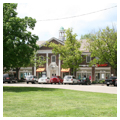Completed in 1929, Shaker Square is an automobile- and transit-oriented shopping center located at the gateway between the city of Cleveland and the residential garden suburb of Shaker Heights. Shaker Square was intended as a commercial anchor for the community, which extends to the southeast. The Van Sweringen brothers developed the shopping complex as part of their master plan for Shaker Heights, but, as built, the square represents an adjustment of their original vision for the site. Originally known as Moreland Circle, this intersection was always understood as an important gateway since the suburb’s two main boulevards and rapid transit lines meet here before heading downtown. In order to accommodate curbside automobile parking to serve the shopping area, architects Small and Rowley transformed the original traffic circle into a square bisected in each direction to create four quadrants. As a result, the square interrupts the north-south thoroughfare of Moreland Boulevard, and directs it around the perimeter. This creates two grass lawns between the buildings and Shaker Boulevard, which continues through with two sets of traffic lanes divided by a median carrying the rapid transit tracks. Each quadrant includes a symmetrical three-sided building with one-story wings flanking a two-story center section that is angled to face the opposite quadrant across the square. The facades vary in their detailing, but they present a unified architectural backdrop to the square: all feature Colonial Revival stylistic motifs and include red brick with white-painted wood decorative elements. One of the buildings in the square housed the Colony Theatre, designed by John Eberson and completed in 1937; while its exterior adhered to the square’s Colonial Revival architecture requirements, the interior displayed the Art Deco details and ornamentation for which Eberson was well known. In 1947–1948, Halle Brothers opened a branch department store in a building that brought a pronounced note of midcentury modernism to the southwest side of Shaker Square. Designed by the local firm of Conrad, Hayes, Simpson, Ruth and Robert A. Little Architects, the new building departed from the period revival style of neighboring structures by subtly blending materials (red brick and limestone) and scale to create a compatible addition. Halle’s Shaker Square was Cleveland’s first a suburban branch of a major downtown department store.
Shaker Square, which is listed in the National Register of Historic Places, embodies similar planning principles, architectural unity, and automobile/public transit orientation as such contemporary commercial developments as J.C. Nichols’ Country Club District in Kansas City, Missouri. In the twenty-first century, Shaker Square retains much of its original architectural character and remains a neighborhood gathering place with a theater, restaurants, and shops.
References
Forgac, Patricia J., “Shaker Village Historic District,” Cuyahoga County, Ohio. National Register of Historic Places Inventory-Nomination Form, 1984. National Park Service, U.S. Department of the Interior, Washington, D.C.
Harwood, Herbert H. Jr. Invisible Giants: The Empires of Cleveland’s Van Sweringen Brothers. Bloomington: Indiana University Press, 2003.
Johannesen, Eric. Cleveland Architecture, 1876-1976. Cleveland: The Western Reserve Historical Society, 1976.
Johannesen, Eric, “Shaker Square Historic District,” Cuyahoga County, Ohio. National Register of Historic Places Inventory-Nomination Form, 1983. National Park Service, U.S. Department of the Interior, Washington, D.C.
Marshall, Bruce T. Shaker Heights. Charleston, SC: Arcadia Publishing, 2006.




